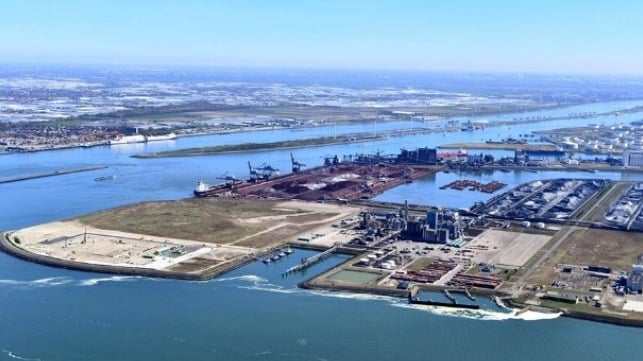Rotterdam Outlines Shore Power Projects, Calling for EC Support

The Port of Rotterdam is pursuing an ambitious strategy to develop shore power to achieve the goal of becoming a zero emission port in 2050. While the port supports the European Commission’s aim to become the first climate-neutral continent by 2050, the port is also calling for a tailored approach instead of top-down regulations to meet the climate goals.
According to the port’s calculations, CO2 emissions at sea represent 87 percent of all emissions of logistics chains via Rotterdam while inland transport is 11 percent and the emissions of berthed ships is just two percent of the total emissions. Yet they recognize the reduction of emissions in the port is important, especially to improve the living environment in surrounding residential areas, as well as contributing to the overall environmental goals.
Together with the Municipality of Rotterdam, the port authority has embarked on an ambitious strategy to realize 8 to 10 new shore power installations in the next five years. Their goal is to learn from these installations and then speed up the uptake of shore power in the second part of this decade. According to the Port of Rotterdam, “This approach is a consequence of the fact that, despite the positive results of shore power, fundamental uncertainties for market parties still exist and the technical potential of shore power for the shipping industry is still being developed.”
These new shore power facilities will be in addition to Rotterdam’s current projects. All moorings for inland vessels in the port, as well as for the Stena Line Hoek van Holland ferry terminal, already have a shore power connection. Also, development is underway for Europe’s largest green shore power connection to supply offshore crane vessels on the Calandkanaal with onshore wind power. Once completed, it will ensure that berthed vessels no longer emit nitrogen and particulate matter to the environment while also result in reduces noise levels from the operations.
Rotterdam’s goal is to supply 90 percent of the ships visiting the public quays in the urban area with shore power by 2030. For roll-on/roll-off, ferries, offshore vessels and cruise ships, the port wants to supply 90 percent of the visits with shore power by 2030. For large container vessels (ULCS: >10,000 TEU nominal capacity) the goal is set at 50 percent. For more complex shipping segments, such as liquid and dry bulk and areas where the technical facilities are not yet available, Rotterdam said it will provide active support in the field of innovation and standardization.
The port authority however is calling on the European Commission to follow a tailored approach to shore power as opposed to top-down regulations. Rotterdam believes that it requires having different ambitions for individual shipping segments and taking into account local circumstances and costs. “We advocate a value chain approach for the rollout of shore power in European ports, based on cooperation and stimulation, rather than regulation.”
Rotterdam is also calling for direct project subsidies to cover the non-profitable top of promising shore power projects. They also believe that a permanent tax exemption for shore power and zero emission fuels is needed to create a level playing field with tax exempted fossil fuels.
By fulfilling these conditions, the port authority says, European policymakers can help deliver zero emission ports, which in turn can help Europe to achieve climate neutrality in 2050.
